
|
Sale 39
Pre-Long Beach Coin and Currency Auction
| Lot |
Photo |
Description |
Realized |
Lot 2061 |
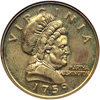 |
(1759) Martha Washington $1.00 size planchet, Reeded Edge. NGC graded Token MS-62. Struck in 1965. See U.S. Pattern Coins Experimental and Trail Pieces, 8th edition by Judd and Bowers, page 289 and J-2131 thru J-2142. (A similar example, 50 cent Martha Washington "Quarter", Judd-2116 in NGC MS-63 realized $25,300 on August 12, 2006.) The obverse depicts Martha Washington, the first First Lady, who faces right; the reverse shows a view of the Washington's stately home in Virginia, Mount Vernon. Struck in the cupronickel-copper, multi-layer composite of our current coins. This large, dollar-size piece was struck from test dies without a specified denomination. Dime-sized, quarter-size and half dollar-size pieces are also known. The USpatterns.com website states "It is believed to be the first metallurgical trials [circa 1965] using the current cupro-nickel clad planchets. The Martha Washington obverse was designed by Edward R. Grove and the reverse is by Philip Fowler." Grove's initials are in small letters on the bust truncation. A satiny and lovely toned piece, dare we call it a "showy" piece because it is so attractive, with excellent striking detail on the hair and cap as well as in every tiny feature of the representation of Mount Vernon, shown three-quarters facing. A piece that should be of interest to the pattern specialist.
Estimated Value $7,500 - 8,000.
View details and enlarged photos
| Realized
$8,625 |
Lot 2062 |
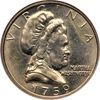 |
(1759) Martha Washington 5 cent size Test Piece. 5.0 gr. NGC graded Token MS-63. Struck in 1965. See U.S. Pattern Coins Experimental and Trail Pieces, 8th edition by Judd and Bowers, page 289. As last, but the five-cent size planchet. Brilliant nickel-bright color and surfaces with an area of minor discoloration below NIA on the obverse. A smoothed rather than sharp impression was left by the pressure of the dies that struck some of the hair and cap detail on Martha Washington, but other areas are much plainer and detailed. Choice rims; freedom from surface marks.
Estimated Value $7,000 - 8,000.
View details and enlarged photos
| Realized
$8,050 |
Lot 2063 |
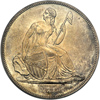 |
1836 Pattern Dollar. Silver, plain edge. Restrike. . J-58. . Low Rarity 6. . P-61. PCGS graded Proof 61. Old green holder. PCGS holder number 4104094. Name below base. Tiny die break second T in States. Early die state and one of the first strikes of the rare name below base. Small flaw as made on Liberty cheek. Well struck and lightly toned. On the obverse of the beautiful Gobrecht design, Liberty is seated on a rock supporting a shield and holding a Liberty Cap on pole. The word LIBERTY is in raised letters on a ribbon that overlaps over the shield, while C. GOBRECHT. F. (i.e., C. Gobrecht fecit, where fecit is Latin for "made this") occupies the field immediately between the base of the rock. This variety, with Gobrecht's name below is an American numismatic classic. As it turned out, criticism with the placing of Gobrecht's name caused Mint Director Robert M. Patterson to have it moved to a less conspicuous location on the rock itself.
All Gobrecht dollars, including the Patterns, were struck with a reflective or Proof finish (i.e., they were probably struck at least twice to bring up the details of the design). This lovely Proof 61 exhibits mirrored though toned surfaces and is uniformly natural in color. "Old silver" is the term collectors like to use. There is some minor roughness on Liberty's cheek, as already mentioned, plus a few tiny contact signs on both sides. A small mark between A and M of AMERCA and a hairline scratch down between M and E of the same word, may be used as reference points. Certainly worth our estimate. The Magdic coin we sold, PCGS PF45, realized $48,875 in February 2005. Die Alignment 4, only 3 known. The National Numismatic Collection that is part of the Smithsonian Institution does not have an example of the 1836 Name below base Gobrecht Dollar (PCGS # 11217) .
The original dies for this silver dollar were made in 1836 by Christian Gobrecht (as an assistant engraver at the U.S. Mint) from sketches made by Titian Peale and Thomas Sully. On the reverse, an American eagle flies upward and to the left in a field of twenty-six stars. Thirteen large stars represent the thirteen original colonies, and thirteen smaller stars depict the subsequent states added to the Union (with Michigan expected to be admitted in 1837). Although the exact mintage of Judd-58 coins is unknown due to lack of mint records, recent estimates suggest that 31 to 75 specimens exist (Rarity-6).
PCGS has recently begun to classify some Judd-58 coins as "originals." It is uncertain that these newly identified coins are in Die Alignment I orientation and were made on 416 grain planchets; or if they represent other die alignment configurations made from an uncracked reverse die. In any case, after 18 years of grading and encapsulating coins, only 22 Judd-58s have been certified by PCGS and NGC combined.
Estimated Value $60,000 - 80,000.
Ex: Lot 1333 Stacks Sale 1955; Dr. Ruby Collection; C.E Gilhousen Sale Lot 1284 October 1973.
View details and enlarged photos
Check results on similar lots
| Realized
$69,000 |
Lot 2064 |
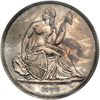 |
1836 Pattern Dollar. Silver, plain edge. . J-60, Restrike, Rarity 1. . P-65. PCGS graded Proof 55. Light grey toning on both sides. Light mottled surfaces with the fields smooth and yielding little to the short time it spent in circulation or, which is more likely, carried as a pocket piece to show around. One of the 600 pieces restruck in late 1837, this example shows only slight friction over the highpoint of the eagle's breast, and the same slight rub on the hair, head, and breasts of Liberty. Close examination shows the expected number of small contact marks for this grade, including one in the field by the left elbow, but none are large enough to affect the overall grade or dissuade bidders from approaching it in a favorable light. The original toning is splashed across each side of this high grade survivor in a random fashion. A popular type coin (PCGS # 11227) .
Estimated Value $18,000 - 20,000.
View details and enlarged photos
Check results on similar lots
| Unsold |
Lot 2065 |
 |
1839 Pattern Dollar. Silver, reeded edge. . J-104. . P-116. NGC graded Proof 65. Housed in NGC holder 1500609-001. A needle sharp gem with splendid natural toning. the centers are light golden with electric blue irridescense at the borders.This important Pattern issue is often collected with the seated Liberty dollars, so we placed it there instead of among the Pattern issues. The obverse is by Christian Gobrecht with the seated Liberty design, the reverse has an eagle in full flight with the legend UNITED STATES OF AMERICA and ONE DOLLAR around. The strike is as crisp as a North Dakota winter's morning, and the toning must be seen to be appreciated. Deep shades of amber and sunset golds throughout, plus some steel blue iridescence at the rims. What's more, nary a mark or tarnish streak to be found on the surfaces. Full originality can be seen in the colors, through the colors, and glistening from the sleek mirrors. Few are ever seen this high, Proof 65, with beauty beyond compare! Die alignment IV (Pollock), when the coin is turned like a medal, the eagle is flying level. This is the more common die alignment, and these are believed to be restrikes circa 1858 or later during the Robert Coulton Davis years at the Mint. Mint workmen supplied Mr. Davis with various delicacies from the Mint's die library. Some might praise these early indiscretions at the Mint, for reason that our most popular 19th century rarities were made to order during the free-wheeling days before the various scandals broke, and the "restrikes" were brought under control (at least for awhile). Pop 8; 2 in PF66
Struck in silver with a reeded edge. Gobrecht Dollars are among the most confusing series of coins in the whole of U.S. numismatics, and the 1839 is a typical enigmatic date. Most extant 1839 pieces, whether they are originals from 1839 or restrikes from later decades, were struck in Die Alignment IV. The latest A Guide Book of United States Coins observes that 300 1839 Gobrecht Dollars were delivered that year for use in circulation. These were struck from perfect dies in Die Alignment IV. Most survivors are worn and/or impaired to some degree from use in the avenues of commerce. Gem Proofs like this lovely toned Proof 65 are major rarities.
Estimated Value $70,000 - 80,000.
View details and enlarged photos
| Realized
$89,125 |
Lot 2066 |
 |
1839 Pattern Dollar. Silver, reeded edge. . J-104, Rarity 3. . P-116. PCGS graded Proof 58. Old green holder. Mostly untoned. A bright and gleaming specimen whose mirrored luster seems poised to detonate like a Fourth of July skyrocket; plus we find a touch of faint friction on the high points accounting for the conservative grade. More than adequately struck for the Type, these tend to show razor-sharpness on the shield, on Liberty's gown and hair, as well as on the eagle's body. Definitely a coin to choose if you desire to own a representative example of Gobrecht's artistic silver dollar masterpiece. Pop 1; 35 finer. (PCGS # 11446) .
Estimated Value $20,000 - 22,000.
View details and enlarged photos
Check results on similar lots
| Realized
$23,000 |
Lot 2067 |
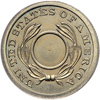 |
1851 Pattern Cent. Copper-nickel, reeded edge, unperforated restrike. . J-131. . P-155. PCGS graded Proof 65. This unadorned dateless pattern includes the legends CENT/ONE TENTH SILVER on the obverse, while UNITED STATES OF AMERICA and a small wreath decorate the reverse. Struck in copper-nickel with a reeded edge. Judd-131 is generally believed to be a restrike, since the centers are unperforated dissimilar to the annular Judd-127 to Judd-129 counterparts. Judd-131 is listed as R.8 in the Bowers revision of Judd (2003), although uspatterns.com counters that "about a half dozen are known." A die break, as made, is noted on the rim below LV in SILVER. A boldly struck and glistening specimen with gem quality surfaces and only a hint of tan patina. Pop 2; none higher. (PCGS # 11558) .
Estimated Value $11,000 - 12,000.
View details and enlarged photos
Check results on similar lots
| Unsold |
Lot 2068 |
 |
1854 Unique Pattern Cent. . J-157A. NGC graded Proof 64. Unusual wheel spiral strike. First we have seen on a Pattern and distinctive for this rare item. Similar to the reverse Pattern on a slug, only in this case the mint used an 1854 silver dollar as the "model." Lightly toned. (In submitting pieces of this Pattern for examination on January 17, 1854, Director of the Mint Snowden explained that these were prepared solely to show the size and the character of the metal, not the design. In fact the obverse die was prepared by a copying lathe from a silver dollar obverse. This fact explains the concentric lines blurring the design of Liberty, the distortion of the stars and the incompleteness of the numerals in the date.)
Note: Struck with a reeded edge in a German silver alloy, 20% nickel, 71% copper, 9% zinc. Judd-156, Judd-157, Judd-158, and Judd-158a are also from the same dies, but the alloy differs slightly. This confuses the number of survivors for each specific Judd number, since they cannot be distinguished by color or weight. However, all varieties are clearly very rare. According to uspatterns.com, Judd-157A was discovered by Jay Parrino, and first reported in an April 1998 edition of Coin World. This lightly toned steel-blue and chestnut piece has subtle satin luster and a tiny spot on the obverse rim near 6 o'clock.
Estimated Value $10,000 - 11,000.
View details and enlarged photos
| Unsold |
Lot 2069 |
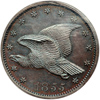 |
1855 Pattern Cent. Bronze, plain edge. . J-168. . P-193. NGC graded Proof 65 Brown. Lovely bluish-violet on both sides. The obverse with James B. Longacre's impressive (and in this instance, extremely sharp and crisply detailed) large eagle motif, one of the most handsome examples we have come across in any grade. The lovely brown surfaces glow with steely blue iridescence, which the photographs finely capture for the appreciative viewer of the sale catalog or online photos.
Estimated Value $2,000 - 2,500.
View details and enlarged photos
| Realized
$3,680 |
Lot 2070 |
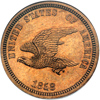 |
1858 Pattern Cent. Copper-nickel, plain edge. . J-202. . Rarity 5. . P-245. NGC graded Proof 66. Medium golden brown. Full, razor-sharp strike characterizes every element of this pretty design. Shimmering reflective tendencies in the fields are most clearly seen as the coin tips at an angle into a light. In addition to the mirrors, there are delicate pinkish-apricot highlights to the otherwise honey-tan surfaces, plus a lack of contact marks which further enhances the appeal. Tied for finest known! Pop 2; none finer at NGC. (PCGS # 11867) .
A small eagle files left on the obverse with the legend UNITED STATES OF AMERICA around the border and the date 1858 below. This eagle has long been called the "Skinny Eagle" in certain numismatic circles. The reverse is similar to that employed in the production of regular-issue 1859 Indian cents. It features the denomination ONE CENT surrounded by a laurel wreath with clusters of five leaves. Struck in copper-nickel with a plain edge.
Similar in design to both the Flying Eagle Cent of 1856-1858 and the first-year Indian Cent of 1859, this is a popular Pattern among numismatists who specialize in regular-issue small cents. At least one example is known with 180-degree, or medallic alignment of the dies.
Estimated Value $5,000 - 6,000.
View details and enlarged photos
Check results on similar lots
| Unsold |
Lot 2071 |
 |
1859 Pattern Cent. Copper-nickel, plain edge. . J-228. . P-272. PCGS graded MS-65. This is the adopted design of 1860 onwards. Here is a pattern that is occasionally collected in the regular issue collection. It is one of the few patterns struck with non-proof dies. It is also one of the more available patterns with an estimated mintage of 300 to 500 pieces.
This example is fully struck with lots of cartwheel luster. There is a minor speck by the T in STATES. Pop 59; 6 finer in 66. (PCGS # 11932) .
Estimated Value $2,700 - 3,000.
Ex:The "Chiro" Collection. Eagle Eye Photo Seal accompanies this lot.
View details and enlarged photos
Check results on similar lots
| Realized
$1,725 |
Lot 2072 |
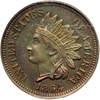 |
1864 Pattern Cent. Copper-aluminum, plain edge. . J-355A. . High Rarity 7. PCGS graded Proof 63 Brown. Old green holder (serial number 1303671). Lovely irridescent brown and sea-green toning. Struck from regular issue 1864 No L Indian cent dies, with a plain edge on a thin bronze planchet. The older generation PCGS holder asserts the piece to be Judd-355A, which the Kosoff-edited (1982) seventh edition of Judd lists as bronze, thin planchet. The eighth edition (2003) delists the variety, which uspatterns.com states is "probably a mint error." Since the present piece is a Proof, another possibility is that it is an example of Judd-353 or Judd-355, which are predominantly copper but contain 7% to 10% zinc. This well struck and unabraded specimen displays beautiful aquamarine and pink-rose toning. Pop 1; none finer (PCGS # 60523) .
Estimated Value $3,500 - 4,000.
View details and enlarged photos
Check results on similar lots
| Unsold |
Lot 2073 |
 |
1864 Pattern Cent. Copper, plain edge. . J-356B. . 87%CU, 13% NI. . P-427. NGC graded MS-66. A fully brilliant gem. Nicely struck on each side, as well, the brilliant surfaces have a sheet of light tan luster that shimmers and sparkles and is uninterrupted by any tarnish or spotting. Don't expect the usual halfhearted impression left by the striking of the (sometimes worn) dies that made regular strikes of this year; for we are glad to report the opposite is true. This is a very bold Pattern cent with sharp centers including strong LIBERTY and headband, plus full feather vanes.
Estimated Value $7,000 - 8,000.
View details and enlarged photos
| Unsold |
Lot 2074 |
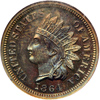 |
1864 Pattern Cent. Copper, plain edge. . J-356a. . P-427. NGC graded Proof 64 Brown. Attractive turquoise and gold toning. While both the obverse and the reverse of this example mimic those of the 1864 No L business strike cent, this pattern was struck on bronze planchets whose thickness resembles that of the copper-nickel issues. A seamless mahogany-brown Gem with lovely blue sheen and iridescence, razor-sharp and imposing. Extremely rare. Pop 2; 1 finer in 65. (PCGS # 60525) .
Estimated Value $2,200 - 2,500.
View details and enlarged photos
Check results on similar lots
| Unsold |
Lot 2075 |
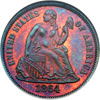 |
1864 Pattern Dime. Copper, plain edge. . J-381. . Low Rarity 7. . P-449. NGC graded Proof 66 Red & Brown. Violet and blue iridescense. Regular die trial striking of the 1864 seated dime. Struck in copper with a reeded edge. This specimen is the finest survivor of this rare die trials striking to have received a Proof-66 numeric grade from the leading certification services. The obverse reveals original reddish-orange luster intermingled with copper-brown and cobalt-blue to purple toning. The reverse displays a more uniform copper-brown appearance, but one can discern rich cobalt-blue and lavender undertones as the coin dips into a light. The best part of it is, above and beyond the beautiful toning, is that devices re fully struck with nary a detracting contact mark in evidence. Pop 1; none finer at NGC. (PCGS # 60552) .
Estimated Value $5,000 - 6,000.
View details and enlarged photos
Check results on similar lots
| Unsold |
Lot 2076 |
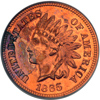 |
1865 Pattern Cent. Copper, plain edge. . J-403. . High Rarity 7. . P-471. PCGS graded Proof 63 Red. Old green holder. Slight discolaration in the left obverse field. Very rare regular dies trial piece Pattern, struck in copper. Pop 1; none finer. (PCGS # 80579) .
Estimated Value $12,000 - 14,000.
View details and enlarged photos
Check results on similar lots
| Unsold |
Lot 2077 |
 |
1869 Pattern Dime. Copper, reeded edge. . J-704. . Low Rarity 7. . P-783. NGC graded Proof 65 Brown. Gorgeous sea-green toning. Tied for finest-certified honors with the brown color designation, this is a wonderfully original Gem. Both sides are richly toned in copper-brown shades through which one can discern mixed antique-gold, powder-blue and pale-apricot undertones as the surfaces resonate under a light. Full striking detail is seen throughout, and as before with several of the fine Patterns from this consignment, there is not a single detracting blemish. The Standard Silver design with a bust of Liberty facing right on the obverse. Liberty is wearing a diadem, and her hair is tied in a bun. The legend UNITED STATES OF AMERICA is above and the motto IN GOD WE TRUST is on a scroll below. On the reverse, the denomination 10 CENTS is centered within a wreath of oak and laurel leaves. The inscription STANDARD SILVER is above and the date 1869 is below. Struck in copper with a reeded edge. Pop 2; none finer at NGC. (PCGS # 60929) .
Estimated Value $3,500 - 4,000.
View details and enlarged photos
Check results on similar lots
| Unsold |
Lot 2078 |
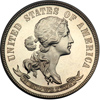 |
1870 Pattern Quarter Dollar. Silver, plain edge. . J-901. . High Rarity 6. . P-1016. PCGS graded Proof 66 Cameo. Brilliant white Cameo Gem. Sleek white in color with an strong contrast between the frosty devices and gleaming mirror fields. Possibly the finest known Judd-901 quarter dollar. Pop 1; none finer. The only cameo example certified.
The theory behind this petite STANDARD SILVER type of 1869-71 was to introduce subsidiary coins into circulation. In effect, it was hoped underweight money could be used to replace a hodgepodge of Fractional Currency then clogging the streams of trade. Why reduce the weight? The belief was this would discourage hoarding and exportation as was occurring with America's regular issues then being struck. This theory never made it into practice in the 19th century; by 1878, gold had returned to par against paper money and small change once again stayed in the country after the hoarding ended.
Standard Silver design with a right-facing bust of Liberty on the obverse. Liberty is wearing a headband inscribed LIBERTY and ornamented with a single star, and her hair is tied in a bun. The legend UNITED STATES OF AMERICA is around the border and the motto IN GOD WE TRUST is inscribed on a scroll below. On the reverse, a wreath of corn and cotton surrounds the denomination 25 CENTS and the date 1870. The word standard is above. Struck in silver with a plain edge.
Estimated Value $7,000 - 8,000.
View details and enlarged photos
| Unsold |
Lot 2079 |
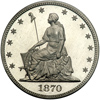 |
1870 Pattern Half Dollar. Aluminum, reeded edge. . J-937. . P-1044. PCGS graded Proof 65. Encased in PCGS holder 21425251. Spot free and brilliant. The obverse exhibits Liberty seated facing left, with a Liberty pole behind her. She holds an olive branch in her left hand, and supports a shield with her right hand. The reverse is from a regular issue Liberty Seated die. Struck in aluminum with a reeded edge. A well struck, lightly toned, and carefully preserved specimen, by all measures, a gleaming Gem! Tied for finest with three PCGS-certified Judd-937 Halves, one or more of which could represent duplicate submissions. NGC has yet to certify an example of Judd-937. Pop 3, none better. (PCGS # 61183) .
Estimated Value $9,000 - 10,000.
Ex: Dr. Richard P. Ariagno Collection, Part II (Bowers and Ruddy, 6/1980), lot 4898; Heritage 9/2004:8472.
View details and enlarged photos
Check results on similar lots
| Unsold |
Lot 2080 |
 |
1870 Pattern Half Dollar. Copper, reeded edge. . J-959. . High Rarity 7. . P-1110. PCGS graded Proof 66 Red & Brown. A mahagony Gem Proof. One of the finest survivors of this exceedingly rare Pattern striking, both sides are predominantly lustrous with dominant medium-red color. As befits the RB designation, there is also some intermingled light-copper patina, but this feature is not discernible at all angles. Shimmering reflectivity is noted, as is a smooth, Gem-quality sheen. Pop 2; none finer. Additionally, neither service reports an example of Judd-959 in full Red.
Standard Silver design with a bust of Liberty facing right on the obverse. Liberty is wearing a headband inscribed LIBERTY and ornamented with a single star, and her hair is tied in a bun. The legend UNITED STATES OF AMERICA is around the border, and the motto IN GOD WE TRUST is present on a scroll below the bust. The reverse exhibits a wreath of corn and cotton surrounding the denomination 50 CENTS and the date 1870, as well as the inscription STANDARD at the upper border. Struck in copper with a reeded edge.
The pieces referred to by the catch-all title of "Patterns" are among the rarest coins ever struck in the United States Mint. There have been many attempts to define the U.S. Pattern coin family as a whole. While there are still a few exceptions, we believe that the definition included in the preface to the ninth edition of the book United States Pattern Coins: Complete Source for History Rarity, and Values by Dr. J. Hewitt Judd is the among the most comprehensive ever offered. According to this definition, "A pattern coin is one that was struck at the Philadelphia Mint (with a few exceptions) for purposes of testing a design or concept, or perhaps from unusual die pairs, or in unusual metals, or to create delicacies for collectors, but which differs from normal circulation coins of standard design, date, and metal." As a rule, patterns are exceedingly rare coins. Their original mintages are unknown, although the number of pieces extant, as well as the reasons for their striking, suggest that very few specimens were prepared. Indeed, most patterns were produced to the extent of only a handful of coins. Patterns also offer considerable opportunity for continued study, as the circumstances surrounding the striking of many types and issues remain shrouded in mystery (PCGS # 71205) .
If in a spare moment you will take time to scan the list of the various Pattern coins struck between 1868 and 1871, you will see a large expansion in the number of types. According to historians, Philadelphia Mint officials were petitioned (often behind closed doors) by collectors wanting a piece of the action. Collectors had heard rumors how privileged individuals were receiving these rare and beautiful Pattern coins. Naturally, they wants some for their own; and before the practice was halted the Mint Director and his allies obliged.
Estimated Value $7,000 - 8,000.
View details and enlarged photos
Check results on similar lots
| Unsold |
Lot 2081 |
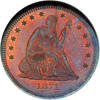 |
1871 Pattern Quarter Dollar. Copper, reeded edge. . J-1102. . High Rarity 7. . P-1238. NGC graded Proof 67 Red & Brown Cameo. A gorgeous gem. Magenta and electric blue. Obverse and reverse: The dies used to coin regular-issue Proof coins this year. Blazing red surfaces underlie the intense purple-blue luster creating superb color and aesthetic appeal. Probably a good many off-metal "die trials" as they are called are not as carefully struck as this superb Proof 67 piece, with no suggestion or even a whisper of soft strike. Nor are there any carbon spots, the coin is exceptional. Pop 2; none better.
According to the Uspatterns.com website, these pieces were deliberately made for sale to collectors and not really "trials" in the sense usually understood. In early 2001, several articles in Coin World by Quentin David Bowers, a noted scholar, discuss such practices at the mint in those years of providing pieces d'caprice to favored collectors. Donald Taxay, too, has extensive coverage in his U.S. Mint and Coinage book published in the 1970s. Examples of the Pattern 1871 quarter dollar are also known in aluminum and nickel.
Estimated Value $7,500 - 8,500.
View details and enlarged photos
| Unsold |
Lot 2082 |
 |
1871 Pattern Silver Dollar. Copper, reeded edge. . J-1147. . High Rarity 6. . P-1289. NGC graded Proof 66 Brown. In NGC holder 1727015-013. A magnificent gem example! Light sea-green, blue and golden brown iridescense. James Longacre's Indian Princess obverse with stars around and date below. Reverse as the regular issue. This spectacular coin has aqua blue toning, color that strikes the eye immediately in sharp contrast with the deeper chocolate brown surfaces which provides a foundation for the sharp relief elements of the design. Turned in the left, turned to the right, the blue iridescence jumps from the entire surface. Close inspection reveals faint accents of violet as well. A most unusual appearance, but striking, very beautiful and rare so fine. Pop 1; none finer at NGC (PCGS # 61409) .
Estimated Value $9,000 - 10,000.
View details and enlarged photos
Check results on similar lots
| Realized
$11,500 |
Lot 2083 |
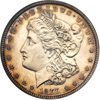 |
1877 Pattern Half Dollar. Silver, reeded edge. . J-1504, High Rarity 7. . P-1658. PCGS graded Proof 63. A hint of light gold toning. Housed in PCGS holder 08815106. Bright silver centers give way to rich halos of deep gold, violet, and rose. Obverse similar to that of the Morgan dollar which followed for general circulation in the next year 1878. Lightly cleaned at some time in the past, since naturally retoned. The present specimen is one of only three pieces enumerated at the uspatterns.com website. Accordingly, this particular specimen of this important rarity is one of the most difficult 1877-dated Pattern half dollars to acquire. As noted above, the presently offered coin has long since recuperated from its light cleaning, and, even with that in mind, it is still a major rarity among pattern issues. The present choice Proof is the only example of J-1504 certified by PCGS in the Proof 63 designation; two other examples of J-1504 have been certified by that firm. We suspect more than one specialist will bid boldly for this numismatic treasure. Pop 1; 1 higher in PF64; PCGS has graded only 3 pieces. (PCGS # 61839) .
Estimated Value $18,000 - 19,000.
View details and enlarged photos
Check results on similar lots
| Unsold |
Lot 2084 |
 |
1879 Pattern Half Dollar. Silver, reeded edge. . J-1597. . High Rarity 6. . P-1791. NGC graded Proof 66. "Washlady" design, a spectacular gem! Brilliant centers surrounded by electric blue irridescense. Silver, reeded edge Wahslady halves are the aristocrats. "This wonderful gem Proof example has brilliant central obverse and reverse, highlighted by a ring of bright blue and iridescent toning. Softly struck over Liberty's ear, and on portions of the eagle, typical of examples featuring the Washlady motif. Perhaps just over a dozen examples of this pattern issue are known," explains the Bowers 11/2001 description where this earlier appeared. NGC holder 371820-004. Pop 2; None finer at NGC. (PCGS # 61975) .
Estimated Value $20,000 - 25,000.
Ex Bowers 11/2001.
View details and enlarged photos
Check results on similar lots
| Realized
$25,875 |
|
|